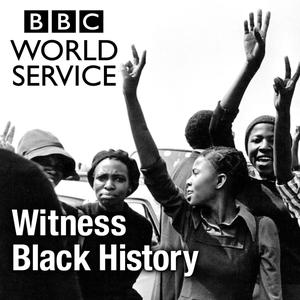
Witness History: Black history
BBC
Listen to and download our programmes
- 9 minutes 54 secondsHaile Selassie in Bath
In 1936, Haile Selassie came to Bath in the west of England to escape Mussolini and the fascists who had invaded Ethiopia.
He bought a property – Fairfield House - and moved his entire family and staff there. He quickly became the talk of the town.
The local paper ran daily updates on the Emperor’s schedule and dispelled rumours such as the Emperor’s beard "having turned white with anguish" or that he was keeping lions in the basement.
Haile Selassie also made a point of indulging in local amusements and even took a trip to the Tropicana outdoor swimming pool in the seaside town of Weston-super-Mare.
Selassie returned to Ethiopia in 1940 after the British helped remove Mussolini. He never forgot his time in Bath and renamed one of his palaces Fairfield in tribute to the British city.
Eye-witness accounts brought to life by archive. Witness History is for those fascinated by the past. We take you to the events that have shaped our world through the eyes of the people who were there. For nine minutes every day, we take you back in time and all over the world, to examine wars, coups, scientific discoveries, cultural moments and much more.
Recent episodes explore everything from football in Brazil, the history of the ‘Indian Titanic’ and the invention of air fryers, to Public Enemy’s Fight The Power, subway art and the political crisis in Georgia. We look at the lives of some of the most famous leaders, artists, scientists and personalities in history, including: visionary architect Antoni Gaudi and the design of the Sagrada Familia; Michael Jordan and his bespoke Nike trainers; Princess Diana at the Taj Mahal; and Görel Hanser, manager of legendary Swedish pop band Abba on the influence they’ve had on the music industry. You can learn all about fascinating and surprising stories, such as the time an Iraqi journalist hurled his shoes at the President of the United States in protest of America’s occupation of Iraq; the creation of the Hollywood commercial that changed advertising forever; and the ascent of the first Aboriginal MP.
(Photo: Haile Selassie during his coronation. Credit: Getty Images)
10 September 2024, 9:00 am - 8 minutes 57 secondsWaris Dirie
In 1987, an unknown 18 year-old Somalian model called Waris Dirie walked into the studio of renowned British photographer Terence Donovan.
She had never had her picture taken before but after striking her first pose it was clear belonged in front of the lens.
Although she says modelling was "easy-peasy” it was not an obvious career path for Waris.
She was born in the Somalian desert to a nomadic family.
When she was young she was forced to undergo female genital mutilation after which her family arranged a marriage for her.
Waris tells Anoushka Mutanda-Dougherty how she walked barefoot across the Somalian desert to escape child marriage and how she became an international supermodel sensation.
Recent episodes explore everything from football in Brazil, the history of the ‘Indian Titanic’ and the invention of air fryers, to Public Enemy’s Fight The Power, subway art and the political crisis in Georgia. We look at the lives of some of the most famous leaders, artists, scientists and personalities in history, including: visionary architect Antoni Gaudi and the design of the Sagrada Familia; Michael Jordan and his bespoke Nike trainers; Princess Diana at the Taj Mahal; and Görel Hanser, manager of legendary Swedish pop band Abba on the influence they’ve had on the music industry. You can learn all about fascinating and surprising stories, such as the time an Iraqi journalist hurled his shoes at the President of the United States in protest of America’s occupation of Iraq; the creation of the Hollywood commercial that changed advertising forever; and the ascent of the first Aboriginal MP.
(Photo: Waris Dirie. Credit: Waris Dirie)
28 August 2024, 9:00 am - 10 minutes 53 secondsSarah Baartman's 200-year journey back home
In August 2002, the remains of an indigenous South African woman called Sarah Baartman were returned to South Africa after almost 200 years away. Sarah died in Paris in 1815 after being forced to perform in European 'freak shows' where people considered to be biological rarities were paraded for entertainment. She had been subjected to racist and degrading treatment and her remains were exhibited at a French museum until 1976.
When Nelson Mandela became the president of South Africa in 1994, he requested that Sarah's remains be returned to her homeland. However, by 1998 that had not happened. Poet Diana Ferrus decided to write about Sarah’s limbo. Her poem became so popular that it was noticed by politicians in France. Diana shares her memories of that time with Matt Pintus.
This programme contains discriminatory language.
(Photo: Sarah Baartman likeness at French museum. Credit: Getty Images)
24 April 2024, 9:00 am - 9 minutes 10 secondsMajor Charity Adams and the Six-Triple-Eight
Major Charity Adams was the first African-American woman to lead a World War Two battalion. It was known as the Six-Triple-Eight (6888).
The 6888 was a majority African-American women’s unit, the women sorted through mountains of post across Europe, using the motto: 'No Mail, Low Morale'.
Charity went on to become lieutenant colonel, the highest possible rank for women in her unit. She died in 2002.
Her son, Stanley Earley, speaks to Marverine Cole.
This was a Soundtruism production for the BBC World Service.
(Photo: American Women's Army Corps Captain Mary Kearney and American Commanding Officer Major Charity Adams inspect the first arrivals to the 6888th Central Postal Directory Battalion Credit. Archive Photos/Getty Images)
19 April 2024, 9:00 am - 10 minutes 13 secondsThe Battle of Versailles: Catwalk clash of American and French fashion
In 1973, a fashion show was held in France which became known as the Battle of Versailles, a duel between designs from modern America and the capital of couture, Paris.
Five American designers, including Oscar de la Renta and Halston, were invited to show their work alongside five of France’s biggest names, including Yves Saint Laurent and Hubert de Givenchy.
The aim was to raise money to help restore Versailles, a 17th Century palace built by King Louis XIV, but the media billed it as a competition between the two countries.
By the end, the Americans were declared the winners. The show also highlighted their industry’s racial diversity on an international stage, with 10 women of colour modelling work by US designers. Bethann Hardison, one of the models, talks to Jane Wilkinson about the lasting impact of the astonishing show.
(Photo: Bethann Hardison at Versailles in 1973. Credit: Jean-Luce Hure/Bridgeman Images)
9 February 2024, 10:00 am - 9 minutes 12 secondsHow Rosa Parks took a stand against racism
Rosa Parks was brought up in Alabama during the Jim Crow era, when state laws enforced segregation in practically all aspects of daily life.
Public schools, water fountains, trains and buses all had to have separate facilities for white people and black people.
As a passionate civil rights activist, Rosa was determined to change this.
In December 1955, she was travelling home from the department store where she worked as a seamstress.
When a white passenger boarded the bus, Rosa was told to give up her seat.
Her refusal to do so and subsequent arrest sparked a bus boycott in the city of Montgomery, led by Dr Martin Luther King.
Using BBC interviews with Rosa and Dr King, Vicky Farncombe tells how Rosa’s story changed civil rights history and led to the end of segregation.
This programme includes outdated and offensive language.
(Photo: Rosa Parks sitting on a bus. Credit: Getty Images)
8 February 2024, 10:00 am - 10 minutesLucha Reyes: Peruvian music star
Lucha Reyes was one of Peru’s greatest singers. She was born into poverty in 1936 and fought terrible health problems and racism throughout her life. But it didn’t stop her becoming a star of Peruvian Creole music - a fusion of waltzes, Andean and Afro-Peruvian styles.
In the early 1970s she recorded hits including Regresa and Tu Voz. One of the few black Peruvian celebrities of her era, she was a trailblazer for black women in the country.
Polo Bances played the saxophone in her band, accompanying her on many of her greatest records. He celebrates her life with Ben Henderson.
(Photo: Lucha Reyes. Credit: Javier Ponce Gambirazio)
7 February 2024, 8:00 am - 9 minutes 54 secondsQueen of the 'fro
In May 1986, 16-year-old Charlotte Mensah went to work in the UK’s first luxury Afro-Caribbean hair salon, Splinters.
In London’s glamorous Mayfair, Splinters had earned a world-class reputation and hosted the likes of Diana Ross.
Charlotte says it looked more like a five-star hotel than a salon and that its owner, Winston Isaacs expected no less than perfection from all his staff.
Now a giant of the hair care industry in her own right, Charlotte has become known as the 'Queen of the 'fro'.
She tells Anoushka Mutanda-Dougherty about her roots and how training at the legendary Splinters changed her life.
This programme includes an account of racial bullying.
(Photo: Young Charlotte in the salon. Credit: Charlotte Mensah)
5 February 2024, 10:00 am - 15 minutes 32 secondsThe funeral of Nelson Mandela
On 15 December 2013, South Africa held the funeral of Nelson Mandela who led the struggle in defeating apartheid and became the country’s first black president.
His ancestral home in the village of Qunu in South Africa’s Eastern Cape hosted 60 world leaders including four United States presidents and two UN secretary generals.
It was the first state funeral held by the country.
Nelson Mandela’s eldest child Dr Makaziwe Mandela tells Josephine McDermott how it took eight years to plan and why it makes her proud to remember that day.
(Photo: Candles are lit under a portrait of Nelson Mandela at his funeral service. Credit: Odd Andersen/AFP via Getty Images)
15 December 2023, 10:00 am - 9 minutes 58 secondsThe Bristol bus boycott
Sixty years ago, there was a boycott of local bus services in the English city of Bristol. The bus company had specified that it did not want to employ black bus drivers.
The boycott ended on 28 August 1963 and the campaign helped to bring about Britain's first laws against racial discrimination.
In 2013, Louise Hidalgo heard from Paul Stephenson and Roy Hackett, who died in 2022.
This programme contains some racist language, used at the time.
(Photo: Bus on Park Street in Bristol in the early 1960s. Credit: Fox Photos/Getty Images)
28 August 2023, 9:00 am - 8 minutes 58 secondsThe Empire Windrush arrives
The Empire Windrush docked at Tilbury in England on 22 June 1948 with 802 people on board from the Caribbean.
The former passenger liner's arrival on that misty June day is now regarded as the symbolic starting point of a wave of Caribbean migration between 1948 and 1971 known as the "Windrush generation".
Sam King was one of the passengers.
He describes to Alan Johnston the conditions on board and the concerns people had about finding jobs in England.
In this programme first broadcast in 2011, Sam also talks about what life was like in their adopted country once they arrived.
(Photo: Empire Windrush at Tilbury docks in 1948. Credit: Daily Herald Archive/SSPL/Getty Images)
22 June 2023, 9:00 am - More Episodes? Get the App
Your feedback is valuable to us. Should you encounter any bugs, glitches, lack of functionality or other problems, please email us on [email protected] or join Moon.FM Telegram Group where you can talk directly to the dev team who are happy to answer any queries.
 Dan Snow's History Hit
Dan Snow's History Hit
 Today in Focus
Today in Focus
 The Rest Is History
The Rest Is History
 History Extra podcast
History Extra podcast
 Witness History
Witness History
 The Inquiry
The Inquiry